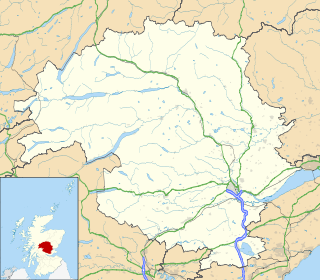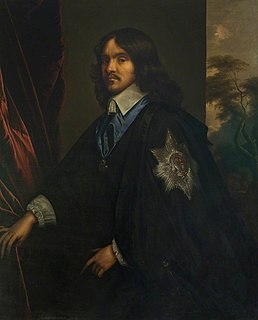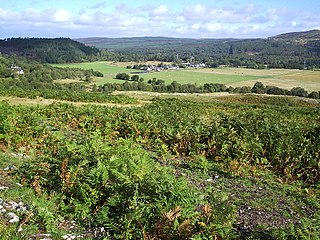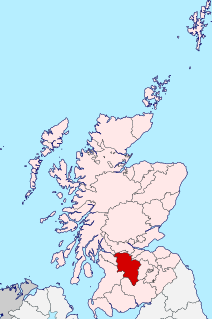Campaign against Cromwell
In 1645 the teenage Somerville was present at David Leslie's first cavalry muster on the Gleds Muir, Tranent. The death of both his younger brothers in 1647 left him the only heir male of his house, and his parents said that he should never leave Scotland. In 1648 his father, having purchased from a cousin the old family seat at Cambusnethan in Lanarkshire, moved there from The Drum, and arranged for his son's marriage with Martha Bannatyne of Corhouse. After Oliver Cromwell's advance into Scotland, the match was put off. The Scots levies concentrated at Edinburgh. Somerville went there with his father, and served in the retinue of the Earl of Eglinton, captain of the king's guard of horse. He saw service, at most of the military actions which took place between the two armies, including the Battle of Dunbar (3 September 1650). [1]

Tranent is a town in East Lothian, in the south-east of Scotland. It is near the A1 road, 2 miles (3km) southeast of Prestonpans and about 9 miles (14 km) east of Edinburgh. It is one of the oldest towns in East Lothian, and built on a gentle slope, about 300 feet (90 m) above sea level. The population of the town is approximately 12,582, an increase of over 4,000 since 2001, making it the second most populated town in East Lothian after Musselburgh. Tranent was formerly a major mining town, but now serves as a commuter town for Edinburgh.

Cambusnethan is a large suburb on the eastern edge of Wishaw, North Lanarkshire in Scotland. It is approximately 1.5 miles (2.4 km) long, straddling both sides of the A722 on a hill overlooking Wishaw.

Oliver Cromwell was an English military and political leader. He served as Lord Protector of the Commonwealth of England, Scotland, and Ireland from 1653 until his death, acting simultaneously as head of state and head of government of the new republic.
After Dunbar, Somerville returned to Cambusnethan, and found it partially occupied by levies of the Presbyterian Association, with whom he had a sharp skirmish. Then in company with Bannatyne of Corhouse, his intended father-in-law, he went north to Perth where Charles II held court. Towards the end of November he returned with his cousin, Major-general Robert Montgomery, who was in command of a body of cavalry that was designed either to operate against, or come to terms with, the Association levies under Colonels Gilbert Ker and Archibald Strachan. After Montgomery had passed Stirling and was on the road to Dumbarton, he gave Somerville a commission to discover if the Association forces were willing to come to an agreement. He went to Renfrew, and arrived in time to take part in a concentration of Royalist forces on Ruglen, which was intended to check Cromwell's advance on Hamilton. [1]

Perth is a city in central Scotland, on the banks of the River Tay. It is the administrative centre of Perth and Kinross council area and the historic county town of Perthshire. It has a population of about 47,180. Perth has been known as The Fair City since the publication of the story Fair Maid of Perth by Scottish writer Sir Walter Scott in 1828. During the later medieval period the city was also called St John's Toun or Saint Johnstoun by its inhabitants in reference to the main church dedicated to St John the Baptist. This name is preserved by the city's football teams, St Johnstone F.C.

Stirling is a city in central Scotland, 26 miles (42 km) north-east of Glasgow and 37 miles (60 km) north-west of the Scottish capital, Edinburgh. The market town, surrounded by rich farmland, grew up connecting the royal citadel, the medieval old town with its merchants and tradesmen, the bridge and the port. Located on the River Forth, Stirling is the administrative centre for the Stirling council area, and is traditionally the county town of Stirlingshire. Proverbially it is the strategically important "Gateway to the Highlands".

Dumbarton is a town in West Dunbartonshire, Scotland, on the north bank of the River Clyde where the River Leven flows into the Clyde estuary. In 2006, it had an estimated population of 19,990.
Four Cromwellian regiments of cavalry (Lord Kirkcudbright's, Colonel Strachan's, Ker's, and Halkett's), then made a night march on Hamilton, and occupied the town, but, after a sharp encounter, were driven out and dispersed the next morning. Somerville, after sending a message to Montgomery, spent three days with the laird of Cathcart, till the country was clear, and then returned to Cambusnethan. Cromwell, however, had rapidly regarrisoned Hamilton, and was making the country dangerous for the Royalists. Somerville and his father therefore retired over the Forth, and were present at the coronation of Charles II at Scone on 1 January 1651. With other Royalists they then paid their respects to the Duke of Hamilton, who was with the Earl of Crawford at the Struthers, Fifeshire. Somerville's father placed him in the king's guard, again only as a volunteer. [1]

Scone is a village in Perth and Kinross, Scotland. The medieval village of Scone, which grew up around the monastery and royal residence, was abandoned in the early 19th century when the residents were removed and a new palace was built on the site by the Earl of Mansfield. Hence the modern village of Scone, and the medieval village of Old Scone, can often be distinguished.

William Hamilton, 2nd Duke of Hamilton KG was a Scottish nobleman who supported both Royalist and Presbyterian causes during the Wars of the Three Kingdoms.
Ludovic Lindsay, 16th Earl of Crawford (1600–1652) took part in the strange plot of 1641 called The Incident. Having joined King Charles I at Nottingham in 1642, he fought at the Battle of Edgehill, at the Battle of Newbury and elsewhere during the English Civil War; in 1644, just after the Battle of Marston Moor, the Scots Parliament declared he had forfeited his earldom, and, following the lines laid down when this was regranted in 1642, it was given to John Lindsay, 1st Earl of Lindsay. Ludovic was taken prisoner at Newcastle-on-Tyne in 1644, following the seven month Siege of Newcastle, and was condemned to death, but the sentence was not carried out, and in 1645 he was released by Montrose, under whom he served until the surrender of the King at Newark-on-Trent. Later he was in Ireland and in Spain and he died probably in France in 1652.
When Charles II decided to march into England, Somerville senior removed his son from the royal guard, to keep him in Scotland. The army's line of march passed within a short distance of the Corhouse, where Martha Bannatyne, Somerville's bethrothed, was living; she sent Somerville junior a message, prompted by Somerville senior. He came and was shut until the army was too far off to be rejoined. The couple married at Lesmahagow church on 13 November 1651, after the Royalist defeat at the Battle of Worcester, with James Somerville still 18 years old. [1]

The Battle of Worcester took place on 3 September 1651 at Worcester, England, and was the final battle of the English Civil War. Oliver Cromwell's Parliamentarian New Model Army, 28,000 strong, defeated King Charles II's 16,000 Royalists, of whom the vast majority were Scottish.

The Battle of Solway Moss took place on Solway Moss near the River Esk on the English side of the Anglo-Scottish border in November 1542 between English and Scottish forces.

The Second English Civil War (1648–1649) was the second of three wars known collectively as the English Civil War, which refers to the series of armed conflicts and political machinations which took place between Parliamentarians and Royalists from 1642 until 1651 and also include the First English Civil War (1642–1646) and the Third English Civil War (1649–1651), all of which were part of the Wars of the Three Kingdoms.
George Leslie, 4th Earl of Rothes (died 24 November 1558) was a Scottish nobleman and diplomat.
Andrew Leslie, 5th Earl of Rothes was a Scottish nobleman. He was the son of George Leslie, 4th Earl of Rothes, and his third wife Agnes Somerville, daughter of Sir John Somerville of Cambusnethan and Elizabeth Carmichael. He succeeded his father as 5th Earl in 1558. His elder half-brothers Norman Leslie and William Leslie forfeited their rights by having been implicated in the murder of Cardinal Beaton in 1546.
Robert Montgomery Hamilton, 8th Lord Belhaven and Stenton KT was a Scottish peer and politician.

The Battle of Carbisdale (also known as Invercarron) took place close to the village of Culrain on 27 April 1650 and was part of the Wars of the Three Kingdoms. It was fought by the Royalist leader James Graham, 1st Marquess of Montrose, against the Scottish Government of the time, dominated by Archibald Campbell, 1st Marquess of Argyll and a grouping of radical Covenanters, known as the Kirk Party. The battlefield has been inventoried and protected by Historic Scotland under the Scottish Historical Environment Policy of 2009.
Sir James Hamilton of Finnart was a Scottish nobleman and architect, the illegitimate son of James Hamilton, 1st Earl of Arran, and Mary Boyd of Bonshaw.
Although legitimated in 1512 while still a minor, he continued to be known as the "Bastard of Arran". As a key member of the Hamilton family, and second cousin of James V, King of Scotland, he became a prominent member of Scottish society.

The Clan Hamilton, also occasionally referred to as the House of Hamilton, is a Lowland Scottish clan.
William Douglas, 1st Marquis of Douglas and 11th Earl of Angus (1589–1660) was a Scottish nobleman.
John Somerville, 3rd Lord Somerville was the son of William Somerville, 2nd Lord Somerville and Janet Mowat. He was a member of the Scottish Parliament. In 1449 he fought with the Scots who defeated the English at Sark. He was also present at the siege of Roxburgh in 1460 during which James II of Scotland died.

The Battle of Preston, fought largely at Walton-le-Dale near Preston in Lancashire, resulted in a victory for the New Model Army under the command of Oliver Cromwell over the Royalists and Scots commanded by the Duke of Hamilton. The Parliamentarian victory presaged the end of the Second English Civil War.
Sir James Hope of Hopetoun (1614–1661) was a Scottish lawyer, industrialist and politician.
Archibald Strachan was a Scottish soldier who fought in the Wars of the Three Kingdoms, reaching the rank of Colonel.
Hugh Somerville, 5th Lord Somerville was a lord of the Parliament of Scotland. He is sometimes reckoned to be the 4th Lord Somerville. He succeeded his brother, John Somerville, 4th Lord Somerville. Hugh and John were sons of William Somerville, Master of Somerville, and Marjory Montgomerie.
Thomas Somerville, 1st Lord Somerville,, was a Lord of the Parliament of Scotland.
William Drummond, 1st Viscount of Strathallan, Lord Drummond of Cromlix (1617?–1688), was a Scottish soldier and politician. He served as a Commissioner for Perthshire in the parliaments of 1669-74, 1681-2 and 1685-6, and at the Convention of Estates of 1678.
The Western Association was a Scottish military association to coordinate the military forces of the south western counties of Scotland during the War of the Three Kingdoms.
Captain William Govan (1623–1661). was a Scottish officer who fought for the Covenanters during the Wars of the Three Kingdoms. He was awarded the honour of presenting Montrose's standard to the Scottish Parliament in 1650. He was accused of deserting the Scottish army later the same year and supporting the English New Model Army under the command of Oliver Cromwell, which was at that time invading Scotland. On 1 June 1661, the year after the restoration of the monarchy, and a few days after he was found guilty of treason, he was hanged as a traitor next to the Mercat Cross in Edinburgh and his head was put on a spike and displayed at West Port, Edinburgh.
John Swinton (1621?–1679) was a Scottish politician active during the Wars of the Three Kingdoms and during the Interregnum. At the Restoration he was found guilty of treason and was imprisoned for some years before being released. In later life be became a Quaker.
William Hamilton was a Scottish antiquarian.


















